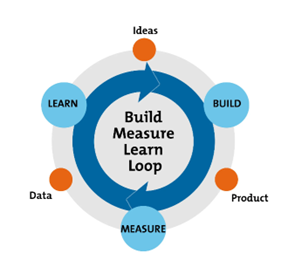Starting up
How to fast-track success with the lean business model
The term ‘startup’ is thrown around a lot, but what exactly is it?
All businesses must start somewhere, but some choose more experimental approaches, like the lean business method, to kickstart a new venture.
So, how do we define a startup, how do you launch a startup and, most importantly, what happens after you start... up?
What is a startup business? 
To be clear, the Australian government has no set definition for what encompasses a startup business. There is no one-size-fits-all approach, so while this term cannot be verified, mutual understanding is that a startup is specifically a business or project at the beginning stage of operations. They are also usually financed by their entrepreneurial founders to develop a scalable business model. This differs to small businesses that focus on serving a local market rather than on scaling their business.
While big tech startups like Facebook, Amazon and Netflix are the most well-known, other considerable startup companies in non-tech sectors include Beyond Meat and WeWork. The common factor between these companies is their focus on innovation, usually aiming to improve or provide variations on an existing product or service. Sometimes appropriately labelled as ‘disruptors,’ they challenge traditional ways of thinking by creating new ways of conducting business.
How to start a startup 
Launching your own business sounds daunting. Understandably so, as there are so many aspects and processes to consider, including:
- write a business plan
- pitch to investors
- assemble a rockstar team
- sell, sell, sell!
Not to mention a probable setback at some point throughout the journey that will either make or break your business. With everything entrepreneurs and business owners have to do, it is no surprise that research shows that 11 out of 12 startups fail.
To have the best chance of success, smart entrepreneurs use the lean startup method. Originally developed by Eric Ries, the lean methodology aims to streamline the startup process by focusing on experimentation rather than elaborate planning. In particular, the method advocates experimenting and developing products that consumers have already expressed an interest in to ensure there’s existing demand for them.
One way to do this is by developing a minimal viable product (MVP). MVP is a version of the product with just enough features to be usable by early adopters. The benefit of this, as the lean startup method states, is that you avoid unnecessary planning and work by further developing the product based on customer feedback early on. This is highlighted in the ‘learn feedback loop’, a main principle of the lean startup method.
The 5 principles of the lean startup method 
1. Entrepreneurs are everywhere
“You don’t have to work in a garage to be in a startup.” – Eric Ries
The common narrative of an underdog team working tirelessly in their garage to develop an innovative new product that you see in the movies is misleading. Ries defines the concept of a startup as a human institution designed to create new products and services under conditions of extreme uncertainty. This means entrepreneurs and developers can be situated in a company of any size, established or not, and in any industry. Thankfully, the lean startup method can be utilised in any of these scenarios.
2. Entrepreneurship is management
Like any business venture, entrepreneurship needs solid management, but a startup won’t necessarily benefit from traditional management processes. Leading your own startup, you’ll need to manage and organise your enterprise or business to effectively handle risks, investors and product experimentation. Just remember, whatever management style you implement should specifically respond to the needs and direction of the business.
“I believe ‘entrepreneur’ should be considered a job title in all modern companies that depend on innovation for their future growth.” – Eric Ries
3. Validated learning
Validated learning encompasses the evidence-based and actionable lean startup process. This entire process of learning and developing as a startup needs to be validated by gathering quantifiable data, such as revenue and user engagement. To be successful, a lean startup uses this information to facilitate genuine improvements and eventually become sustainable.
4. Build – measure – learn
Also known as the feedback loop, ‘build measure learn’ is one of the central principles of the lean startup method. It highlights a sound way to establish and continually improve on a product idea within the early stages of development, while saving time and resources.
Put into practice, the model involves a cycle of creating and testing to gain customer feedback. The cycle doesn’t end when the product is released. This principle aims to continuously develop and improve an offering by listening to your customers and delivering exactly what they want.

5. Innovation accounting
Accountability is key. As much as you love the fun stuff (coming up with new ideas), to be successful, you also need to focus on the boring stuff: how to measure progress, milestones and performance indicators, and how to prioritise work. A standard accounting model won’t work in these instances – a new accounting model for startups is required as well as people who will hold them accountable.
How to use the lean startup model: a case study 
One of the most well-known companies to have utilised the lean startup principles for growth is Dropbox, the file hosting and sharing service.
Released in 2008, Dropbox started as a minimal viable product with a screencast demonstrating key features and functionality of the service. This allowed them to test the demand for their product and gain valuable customer feedback that led to further experimentation.
In just 4 years, the innovative tech service gained 100 million registered users and as of 2021 had 700 million registered users, with almost 15.5 million paid users. Dropbox’s success, and that of many other startup companies, highlights the importance of using the 5 lean principles and methodology.
Leaning your ambitions forward 
As many successful companies have done, centring the customer in your development is essential when using the lean startup method. This means that if you have an idea for a product or service that you think consumers will benefit from, you shouldn’t initially resort to a traditional business plan. Start with a minimum viable product and continuously work through the lean principles to determine whether your product is feasible.
And what happens beyond the startup phase? Continue to use the lean startup principles to develop and reiterate your product and service consumers needs shift. It’s a long-term process, but one that will reward your business exponentially.
Discover your next career challenge
Learn more about the learn startup method and how to put innovation principles into practice for entrepreneutial success with
UQ's Master of Entrepreneuship and Innovation.
